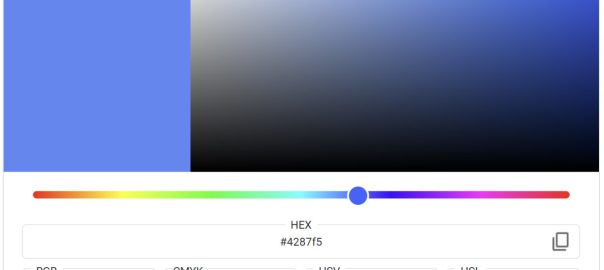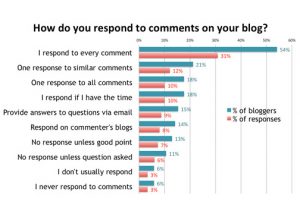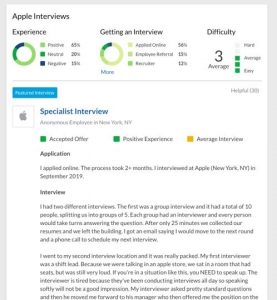By JR Raphael
I’ll let you in on a little secret: Google’s apps and services are absolutely overflowing with buried treasures.
More than any other tech company, Google loves tucking interesting options and features into out-of-the-way places. Some of the best elements of Gmail, Google Calendar, and other popular productivity tools are almost completely out of sight, in fact, and all too easy to overlook if you don’t know where to find ’em.
Once you have a road map, though, these virtual jewels couldn’t be easier to embrace. And once you get yourself in the habit of using them, you’ll never look at Google’s apps the same way again.
So summon your inner adventurer, and let’s get to it: Here are a whopping 77 tips for Gmail, Google Calendar, Maps, Drive, Docs, Sheets, and Search.
Gmail tips
1. Give yourself more room to write
First things first: Gmail’s default compose window for new emails is a small box in the lower-right corner of the screen. That can be nice if you want to keep an eye on your inbox—but it can also be quite distracting when you actually want to focus on what you’re writing.
If you find yourself preferring a more full-screen writing experience, start a new message in the Gmail website and then click the three-dot menu icon in the message’s lower-right corner. Click the option, “Default to full screen?” Then close out of that message entirely and start another new message.
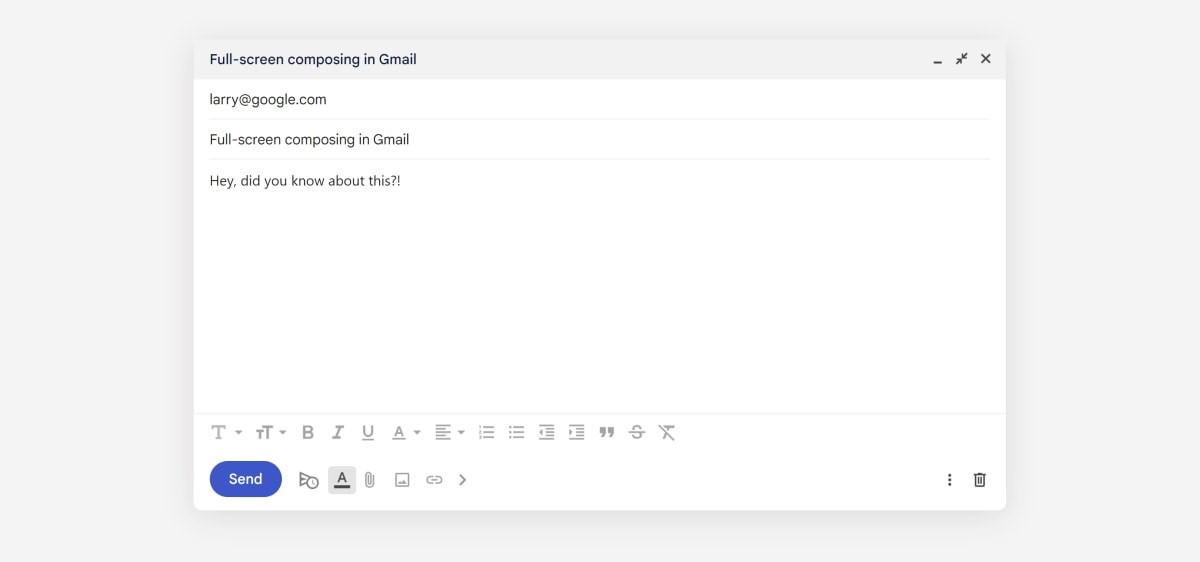
Ta-da! Now your Gmail compose window will always open up as large as your current browser window allows. Should you ever want to shrink it back down into that smaller setup, just click the icon with two arrows pointing inward in the window’s upper-right corner.
2. Unlock Gmail’s speedy triage secret
Are you the type who powers through your inbox message by message until you reach the end? If so, take a peek at Gmail’s tucked-away auto-advance setting. Once you enable it, you’ll automatically be taken to the next email in your list (or the previous email, if you prefer) as soon as you archive or delete a conversation—instead of being taken back out to your inbox, as would typically occur.
In Gmail’s desktop version, you’ll first need to activate the option by going to the Advanced tab of the Gmail website’s main settings area (which you can get to by clicking the gear-shaped icon in the site’s upper-right corner and selecting “See all settings” in the panel that comes up). Find the “Auto-advance” line, click “Enable,” and click “Save Changes” button at the bottom of the screen. Once the website reloads, you’ll need to go back into Gmail’s settings and look for the newly present “Auto-advance” area within the General tab to configure exactly how the option works.
On Android, there’s a separate, independent option within the “General settings” section of the Gmail app’s settings. No such option seems to be present on iOS, unfortunately.
3. Read more, click less
Speaking of reading, one of the simplest and most helpful Gmail settings you can change is the option for “Maximum page size,” located in the General tab of the Gmail website’s settings.
By default, Gmail shows you just 50 email conversations on each page and requires you to click to a subsequent page in order to see more messages. Maybe that setup made sense in earlier days of the internet, when bandwidth was at a premium, but nowadays, all that extra clicking can be an inconvenience.
Save yourself some clicks, and some sanity, by changing that setting from 50 to 100. And be sure to click “Save Changes” at the bottom of the screen when you’re done.
4. Put your emails back in proper order
If you’re using Gmail’s tabbed inbox interface—the one where your messages are sorted into categories such as Social, Promotions, and Updates—you might’ve noticed a strange habit Gmail has on the phone front. For some reason, only in the mobile apps, Gmail rearranges the messages in your Promotions tab to put the emails it sees as being “highest value” at the top.
Practically speaking, that means the messages in that category are often shown out of chronological order, with no obvious rhyme or reason behind their sequence. And you’ll frequently end up seeing days-old messages at the top, with more recent emails buried beneath them.
You can turn off that behavior and restore order to your inbox by toggling a deeply buried setting in the Gmail mobile apps. On Android, open the app’s settings, tap your account name, then tap “Inbox categories” and look for “Enable Top Picks” toward the bottom of the screen. On iOS, go to the “Inbox customizations” area of the app’s settings and look for the “Enable Top Picks” toggle.
However you get there, flip that switch to the Off position. Trust me, you’ll be glad you did.
5. Set yourself up for smarter snoozing
Snoozing is one of my favorite Gmail features, but it’s also one of the most confusing when it comes to settings. The reason: You can actually customize the default times for email snoozing in Gmail—the specific morning, afternoon, and evening times that pop up by default in the various one-click snoozing options—but the setting to make that adjustment isn’t located within Gmail.
Instead, it’s in Google Keep. Go figure, eh? Crazy as it sounds, try this: Pull up the Keep website, click the gear-shaped icon in the upper-right corner, and select “Settings”—or open the equivalent section in the Keep mobile app—and look for the “Reminder Defaults” section in the panel that pops up.
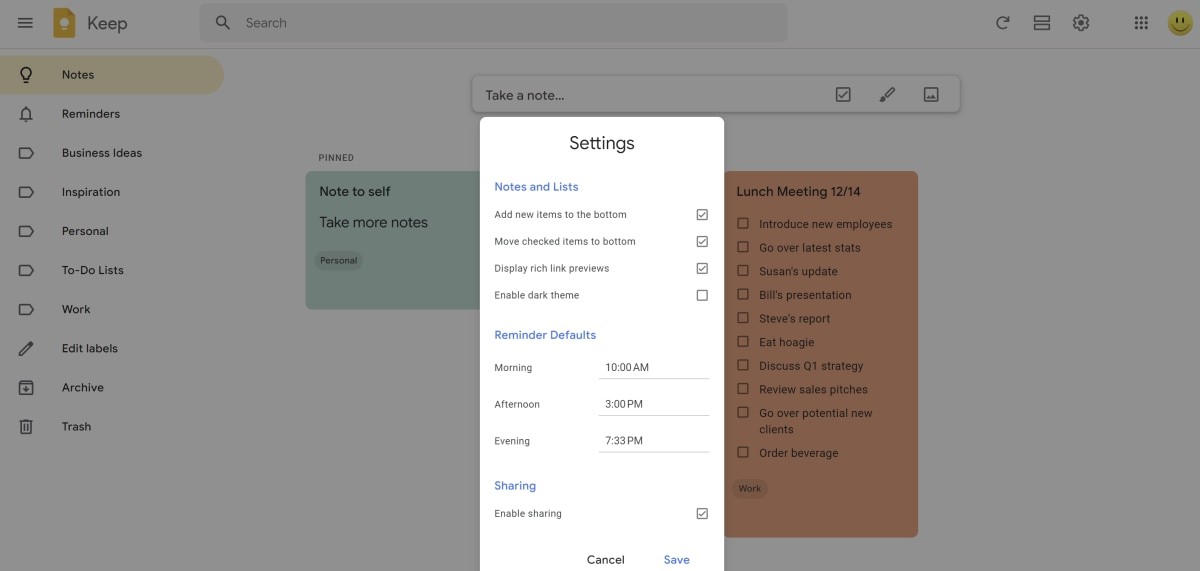
Set the values for Morning, Afternoon, and Evening to whatever times make sense for you, then click “Save” on the website or just back out of the menu on mobile.
Once that’s done, go back to Gmail and snooze a message—and sure enough, you’ll see your new custom times come up within the default suggested options.
6. Knock out two steps in one
I don’t know about you, but almost every time I finish responding to something in my inbox, I archive the message to get it out of my hair. Well, Gmail has a spectacular step-saver that lets you perform both those actions—sending and archiving—in one fell swoop on your computer.
To enable it, look for the “Send and Archive” option on the General section of the Gmail website’s settings. Change to “Show Send & Archive button in reply” (something that isn’t enabled by default), save, and once out, you’ll see a spiffy new blue button next to the regular Send button that’ll let you now send and archive in a single step.
Bonus tip: Once that button is visible, you can also hit Ctrl (or Cmd) and Enter together to trigger the same action without any mouse work required.
7. Clean up your label clutter
It doesn’t take much for Gmail’s labels to get out of hand—and odds are, no matter how many labels you’ve created over the years, there are only a handful that you interact with on a regular basis.
Make your life meaningfully easier by hiding the labels you don’t use often, leaving visible only the ones you genuinely need. Start your cleanup by clicking on the “Labels” tab in the Gmail website’s settings. There, you’ll see a list of all your available labels, along with the ability to set any label as hidden in both the label list—the sprawling list of labels that shows up at the top of the Gmail sidebar—and the message list, which is the list of label options that appears whenever you use the command for adding a label to an individual message.
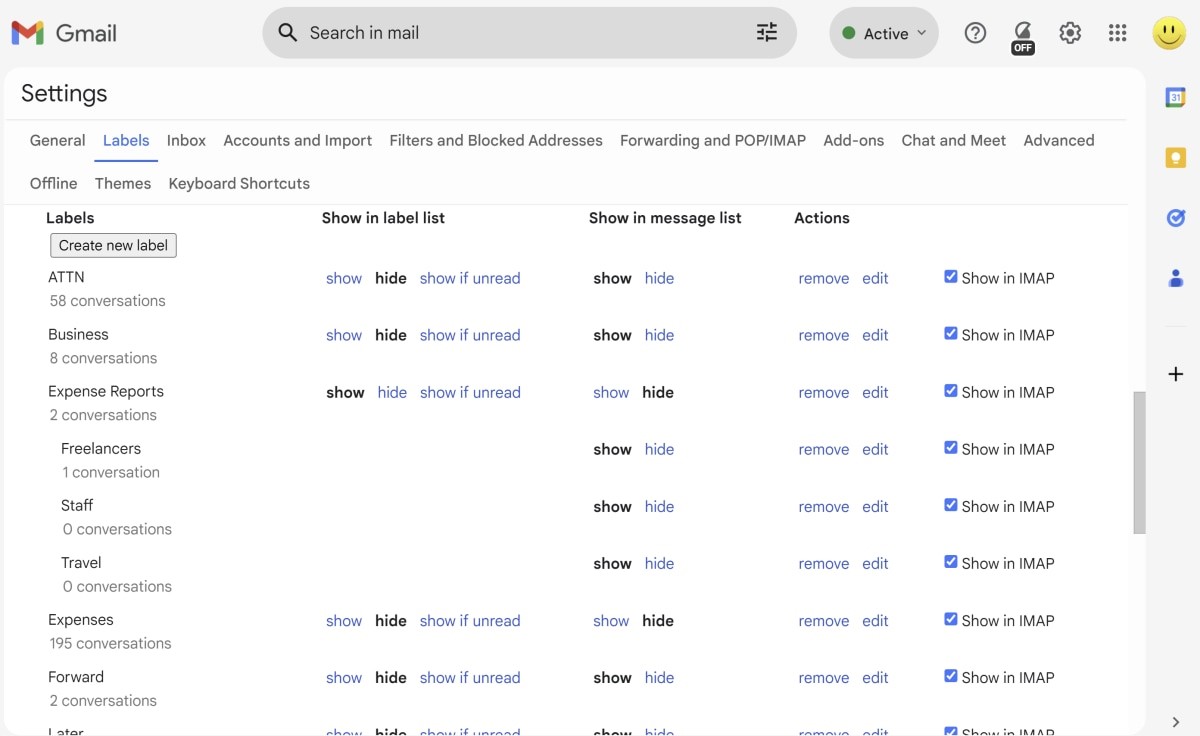
Hide anything you don’t often access in either of those places, and you’ll stop wasting time looking through superfluous stuff.
8. Boost your second-guessing buffer
Gmail has a tremendously useful feature called “Undo Send,” which lets you pull back a message, in case you suddenly reconsider something you said (or included a wildly inappropriate attachment by mistake). By default, though, Undo Send gives you a measly 5 seconds to make that call—which isn’t much time at all, especially when potentially mortifying errors are involved.
Take two seconds now to find the “Undo Send” option in the General section of Gmail’s desktop settings, and you can boost your buffer from 5 seconds to a full 30. There’s little real downside, outside of your messages sitting for an additional 20 or so seconds before they’re actually delivered. And there’s a world of face-saving gained.
Google Calendar tips
9. See more events at a glance
Wish your calendar could show a little more info—with less wasted space? Good news: Google Calendar has a hidden option to increase its display density.
To try it, click the gear in the Calendar website’s upper-right corner, then select “Density and color” and change the “Information density” setting to “Compact.”
10. Claim a custom Calendar view
A little-known fact: Google Calendar can let you create your own custom view in addition to the standard day, week, month, and year arrangements. That’s handy if, say, you want to view your calendar in a zoomed-in two-day perspective or maybe a zoomed-out two- or four-week layout.
Click the gear in the Calendar site’s upper-right corner again, select “Settings,” then click “View options” in the left-of-screen sidebar and adjust the “Set custom view” option to however you’d like.
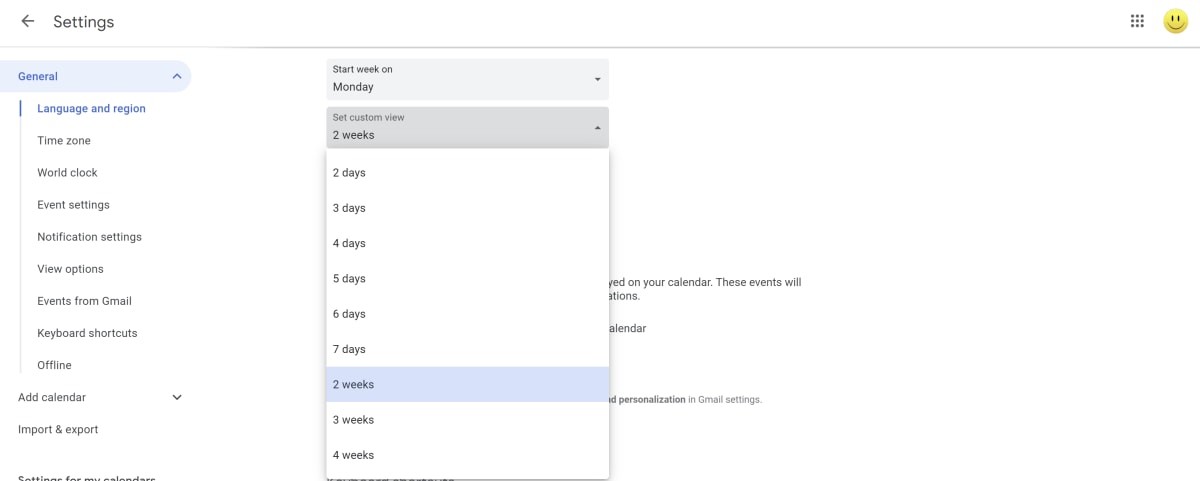
11. Stop focusing on the past
Why distract yourself with events that already happened? Instead, let Calendar dim past appointments so you can focus on what’s next.
Look for “Reduce the brightness of past events” checkbox within “View options” of Calendar’s settings. You’ll notice the difference immediately in Calendar’s week and month views.
12. Get a more global view
You can manage appointments across multiple time zones by activating Calendar’s secondary time zone option, which lets you have events start or end in different locales without the need for mental conversions.
Look for “Time zone” header in the website’s settings, then check the “Display secondary time zone” box, and select the time zone you want. You also can give each time zone a label (“Boston” and “California,” for example) to make things even simpler.
13. Convert time zones like a pro
In addition to its time-zone-converting capability, Calendar can show you a world time clock to give you an at-a-glance view of the current time in any number of places.
Simply seek out “World clock” in the website’s settings. Once it’s activated, you can add however many time zones you want, and they’ll all be displayed in the site’s lefthand sidebar.
14. Jump into the past—or future
One of Calendar’s most helpful shortcuts is also one of the easiest to miss: You can press “g” from any calendar view to jump directly to any specific date, in any year.
That causes Calendar to pop up a box in which you can type any date you want, using either a standard (4/13/06) or text-based (April 13, 2006) format—and transport yourself there faster than you can say “flux capacitor.”
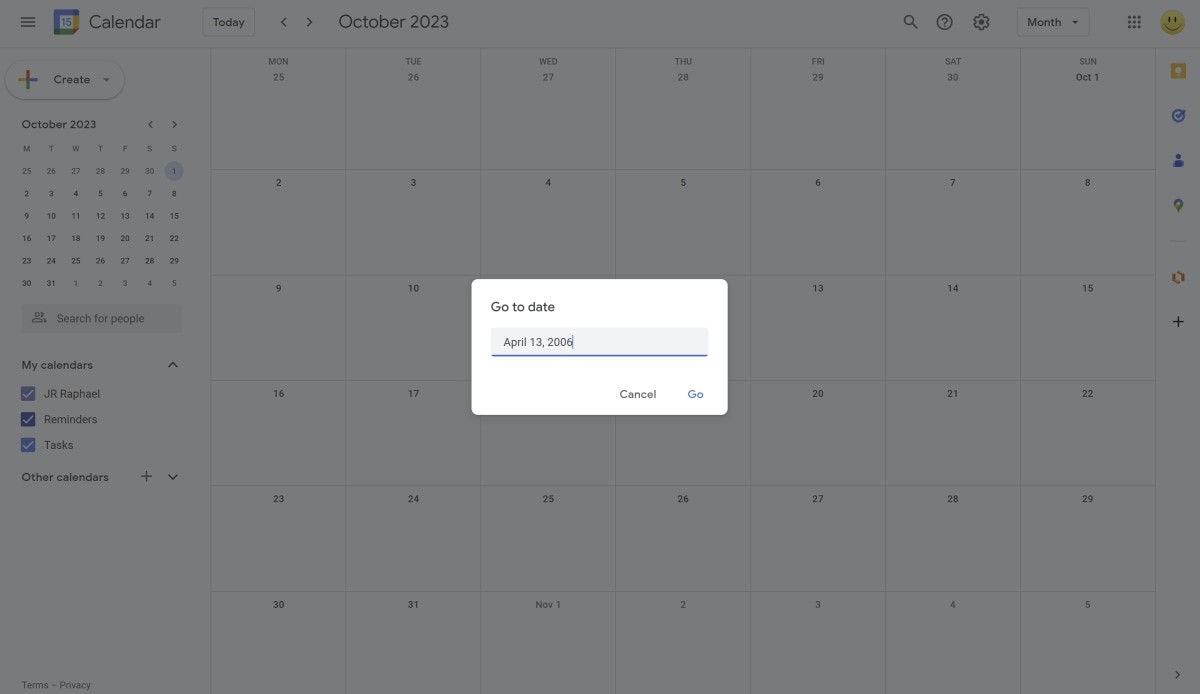
15. Return to the present in a snap
Speaking of smart shortcuts, here’s another one worth remembering: From anywhere on the Calendar site, you can hit the Esc key to jump right back to the main calendar screen. And while looking at any calendar view, you can hit “t” to return to today’s date.
16. Save an event the speedy way
The next time you create a new event, try hitting Ctrl-S once you’ve put in all the information. That’ll let you save the event without having to lift your fingers and mess with your mouse.
17. Uncover Calendar’s undo option
Calendar also has a little-known command that’ll let you undo errant actions—like moving an event by mistake or deleting the wrong appointment. Hit Ctrl-Z or even just “z” by itself on your keyboard. You have only about a 10-second window, but if you catch your slipup soon enough, it’s a great way to fix your flub.
18. Don’t forget the trash
For times when you delete an event entirely and then need to get it back later, make yourself a mental note about Calendar’s tucked-away Trash section. It gives you the opportunity to recover any deleted event for a month after axing. You can find the Trash section by clicking the gear in the site’s upper-right corner and selecting “Trash” in the menu that appears.
Google Maps tips
19. Go completely hands-free
We’ve all been guilty of glancing down at our devices while driving—to look ahead at the next turn, perhaps, or see how long is left in a commute. If you have an Android phone, there’s a better way: Google Maps has a whole series of helpful voice commands that’ll work whenever you’re actively navigating.
Just say “Hey, Google” and then try variations on these examples:
- “What road is this?”
- “What’s my next turn?”
- “What’s my ETA?”
- “How’s traffic ahead?”
- “How’s traffic to work?”
- “Avoid tolls”
- “Avoid highways”
- “Find gas stations”
- “Find restaurants”
- “Navigate home”
- “Take me to McDonald’s”
- “What’s the closest hotel?”
- “Exit navigation”
You can also instruct your phone to make calls, send texts, play music, or look for your next appointment—all without ever taking your eyes off the road.
If your device doesn’t respond to your commands, search your system settings for “Assistant” (but, um, not while you’re driving) to find the Google Assistant settings, then make sure you have “Hey Google” voice detection enabled.
20. Remember where you parked
Open up Maps on your phone and tap the little blue dot that represents your current location. That’ll pull up a hidden menu with some handy options—including the ability to save your current parking location. You can add in your own supplementary notes or photos and even set a timer to remind you when it’s time to move your car.
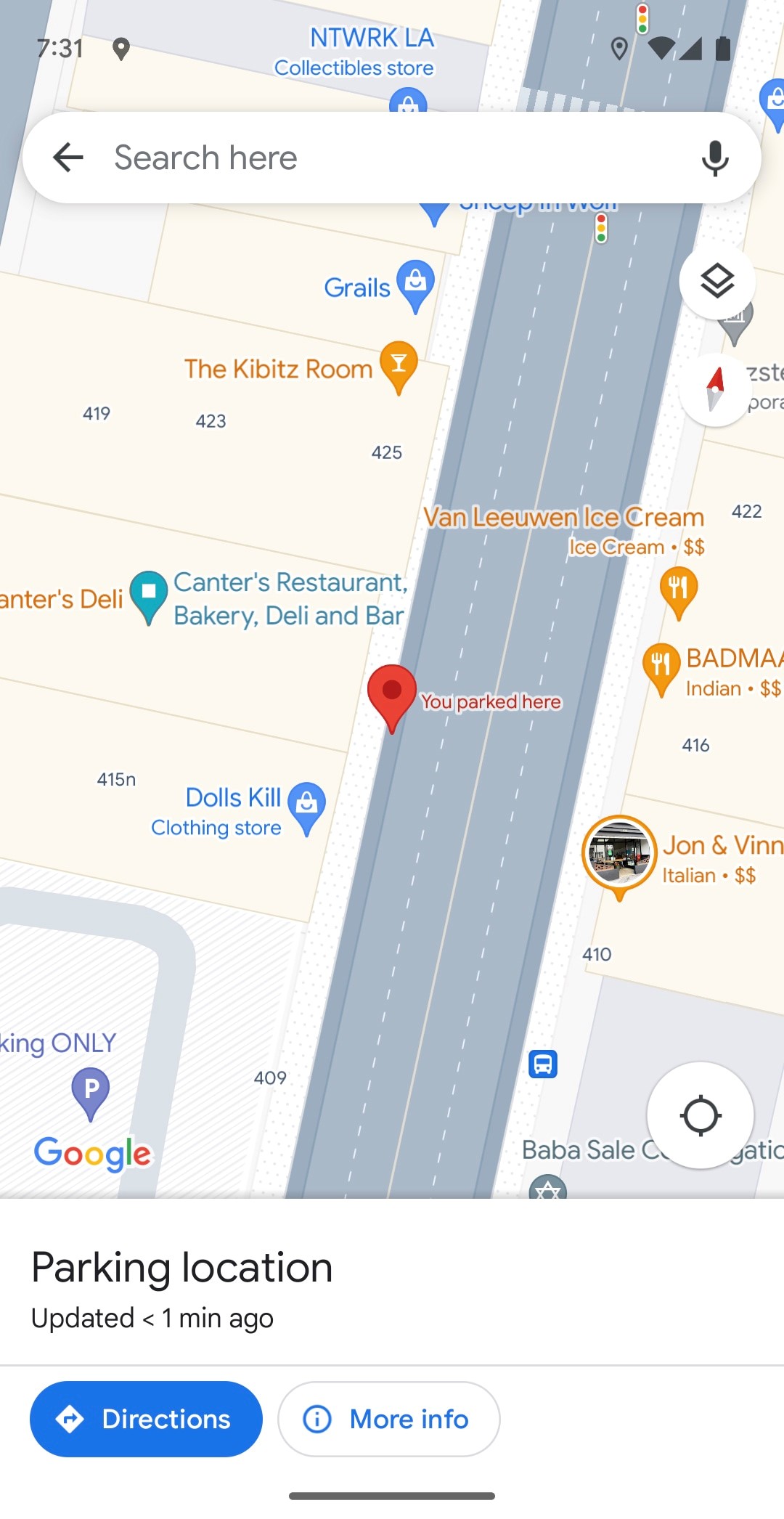
When you’re ready to get back to your spot, look for the saved parking notification on your phone, or just open Maps, and tap the “Parking location” card at the bottom of the screen.
21. Share your location, even while moving
Need someone to find you—or maybe just know where you are? Take a look at Maps’ simple system for real-time location sharing.
To try it, open Maps on your phone, tap the blue dot, and select “Share location.” You’ll be able to set an end time for location-sharing or opt to keep it active until you manually turn it off. Then select any of your contacts to share with or get a private web link to paste wherever you want.
You can also access the sharing function while in the midst of a Maps navigation by swiping up from the white bar at the bottom of the screen and then selecting “Share trip progress.” That’ll share your location with whomever you choose until you reach your set destination.
In either scenario, people who open the link will see an icon showing your current position on a map as you move—within the Maps app, if they have it, or in a regular browser window if they don’t. You’ll see an indicator at the bottom of Maps letting you know location-sharing is active, and you can always stop the sharing by tapping that box.
22. Search along your route while navigating
That swipe-up-while-navigating menu has one other useful pearl: an option to search along your current route.
Activating it will give you one-tap buttons for finding gas stations, restaurants, grocery stores, coffee shops, etc. along your way. You can also type in your own custom search term—if, say, you want to see every Starbucks or Taco Bell that’s on your present route.
23. Find out what’s near anything
Speaking of search, Maps makes it easy to find anything you need even when you aren’t actively navigating. Anytime you want to find specific types of places near your current location or any other spot, tap the search bar at the top of the mobile app and try variations on these queries:
- “Restaurants near here”
- “Pharmacies near Figueroa and 1st Street”
- “Vegetarian restaurants near me”
- “Book stores near UCLA”
- “Gas stations near the airport”
- “Things to do near the Florida Theatre”
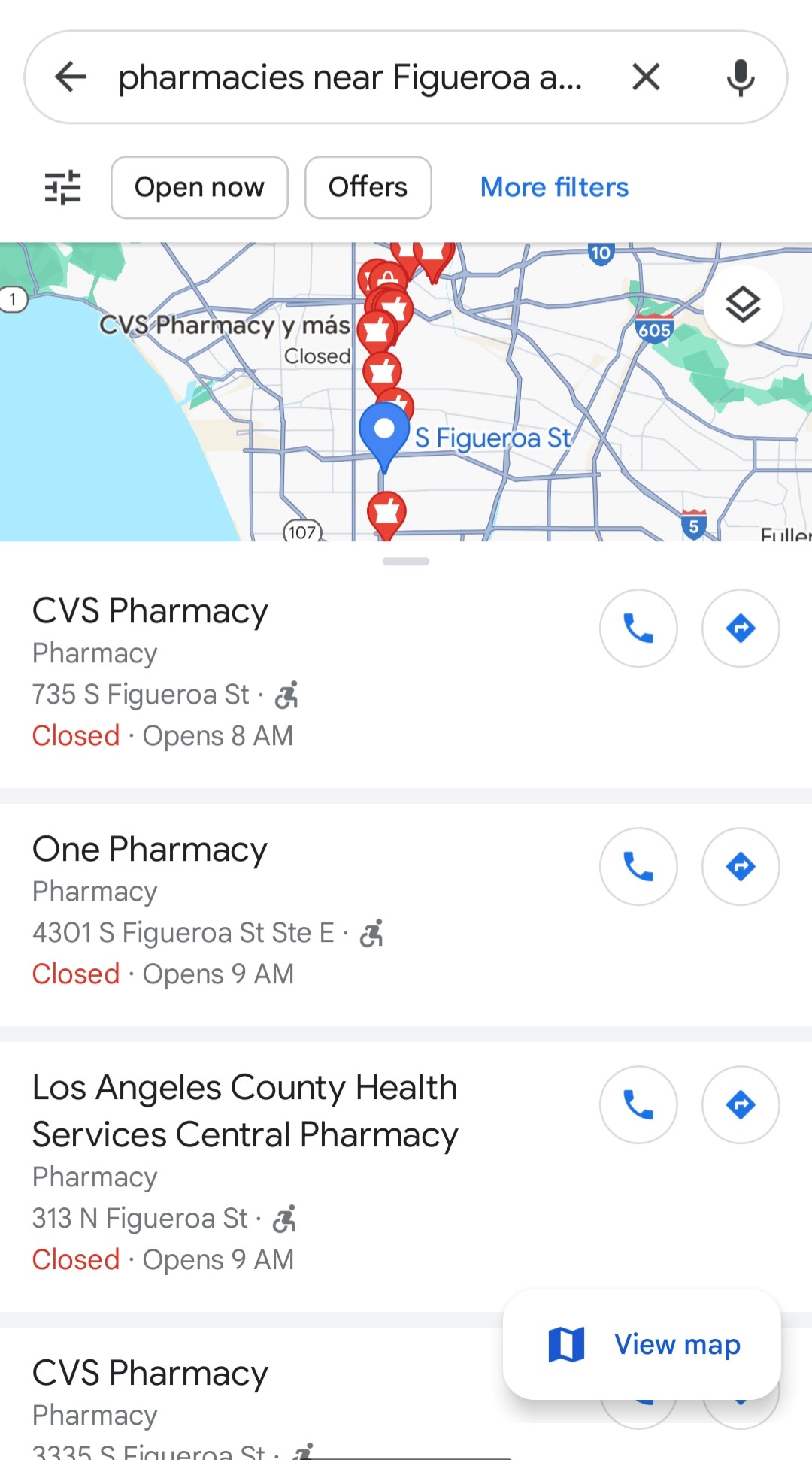
You can also browse to see what’s near your current location by opening Maps and scrolling and swiping through the Explore tab at the bottom of the screen.
24. Get a ticket to ride
The next time you’re looking up a location on your phone and decide to hail an Uber or a Lyft to get there, save yourself some steps and order your ride from right within the Maps app. After searching for a specific place, tap the Directions button and look for the cab-hailing icon (between walker and cyclist) that pops up, showing the amount of time to get there. Tap on the icon, and at the screen’s bottom it will show cost and wait times for whichever ride-sharing apps are installed on your phone—and allow you to hop directly into the ride-ordering process within that app.
25. See how busy businesses are
Before you head out to the grocery, your favorite deli, or even the DMV, let Maps show you how long of a wait you’ll face upon arriving. Search for the spot in the Maps app—or find and tap it within your current map view—then tap the business’s name in the white bar at the bottom of the screen and scroll down until you see the section labeled “Popular times.”
There, you’ll find a graph of the typical crowds at your current day and time and often also a live report of exactly how busy it is at that very moment. You can look ahead to find average data on crowd congestion for any other day and time as well.
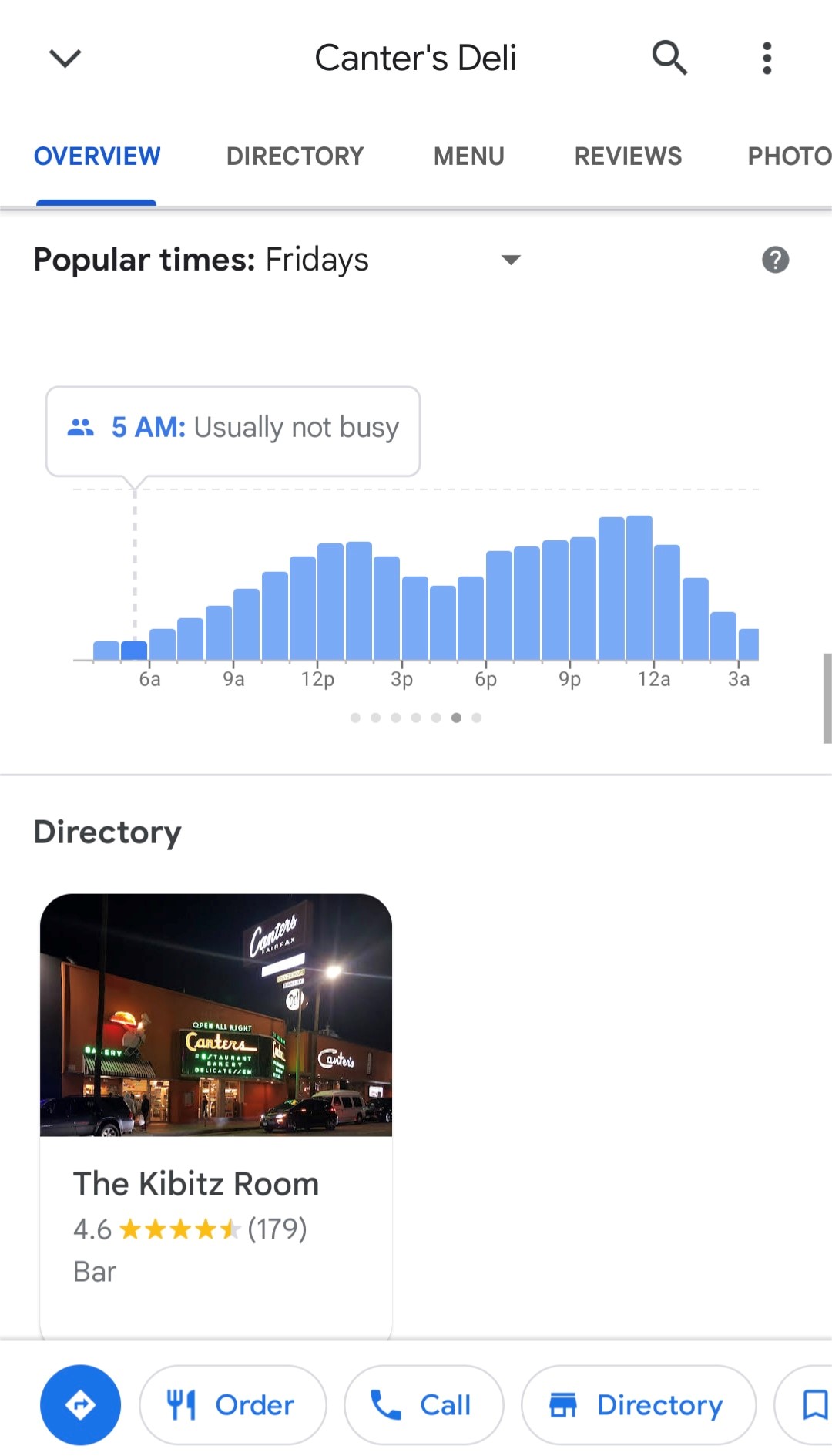
26. Beam a map directly to your phone
When you’re looking up directions on your computer, save yourself a step and beam them directly to your phone for easy on-the-go access.
Click on an inconspicuous option that appears when you search for a place or pull up directions on the Google Maps website. It’ll be in the box on the left side of the screen—either as an icon beneath the place’s name or address, if you’re looking at a regular map, or as a plain-text link immediately above the route options, if you’ve already pulled up directions. (If you’ve clicked through to a specific route, it’ll be an unlabeled icon immediately to the right of the travel time estimate. And yes, there’s some irony in the fact that you practically need a map to find this feature.)
Click whichever version appears, and you’ll see a list of devices that are connected to your Google account. Android devices should show up automatically, while iPhones will require you to first install and sign into the Maps app and then enable notifications within the app’s settings.
Whichever way you go, the Maps info will show up as a notification on your device seconds after you send it over.
27. See time-specific traffic estimates
You can find out how long a drive is likely to take at any given time with Maps’ intelligent traffic estimation tool. Just search for a location in Maps’ desktop version, then click Directions and type in whatever starting point you want.
At the bottom of the same box where you typed the address, you’ll see a line that says “Leave now.” Click the downward-facing arrow next to that, then select either “Depart at” or “Arrive by” to view the probable traffic conditions and estimated trip total for any specific day and time.
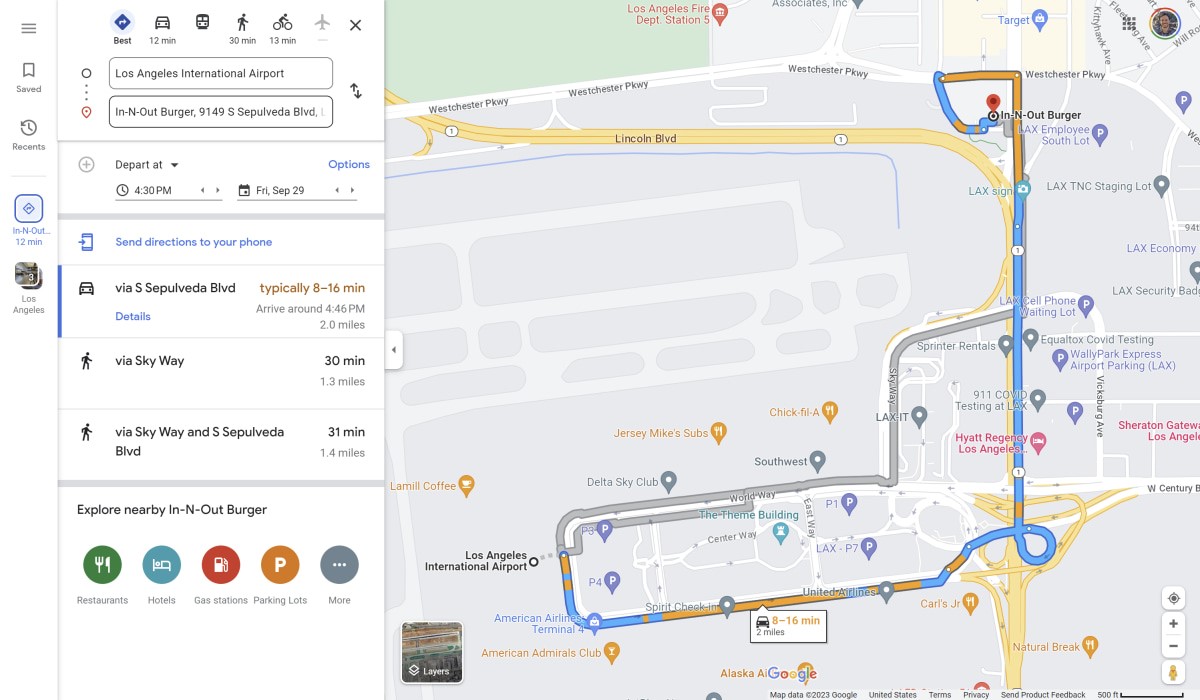
28. Get parking info before you go
Nothing’s more annoying than arriving somewhere at the last second and having to scramble for where to park. Maps can help—at least, if you have an Android device. Before you hit the road, search for your destination in the Google Maps app on your phone. Tap the Steps button toward the bottom of the screen, then look for “Find parking.” However, the parking feature is only available in some U.S. cities, and Google doesn’t specify which ones. So, if you don’t see the “Find parking” option, it’s most likely not live in your area.
29. Measure the distance between multiple points
Want to map out your morning jog—or maybe just know exactly how far you have to travel on a particular trip? Maps can precisely measure the distance between two or more points, all the way down to the second decimal.
On your phone, tap and hold your finger on your starting point. That’ll cause a red pin to appear along with a white box showing more info about the location. Swipe up on the box and select the “Measure distance” option. After that, use your finger and the blue + to find and select the second point. Repeat as many times as needed to measure your full path.
On a computer, right-click on your starting point and select “Measure distance” from the menu that appears, then click on each subsequent point in your path to get measurements.
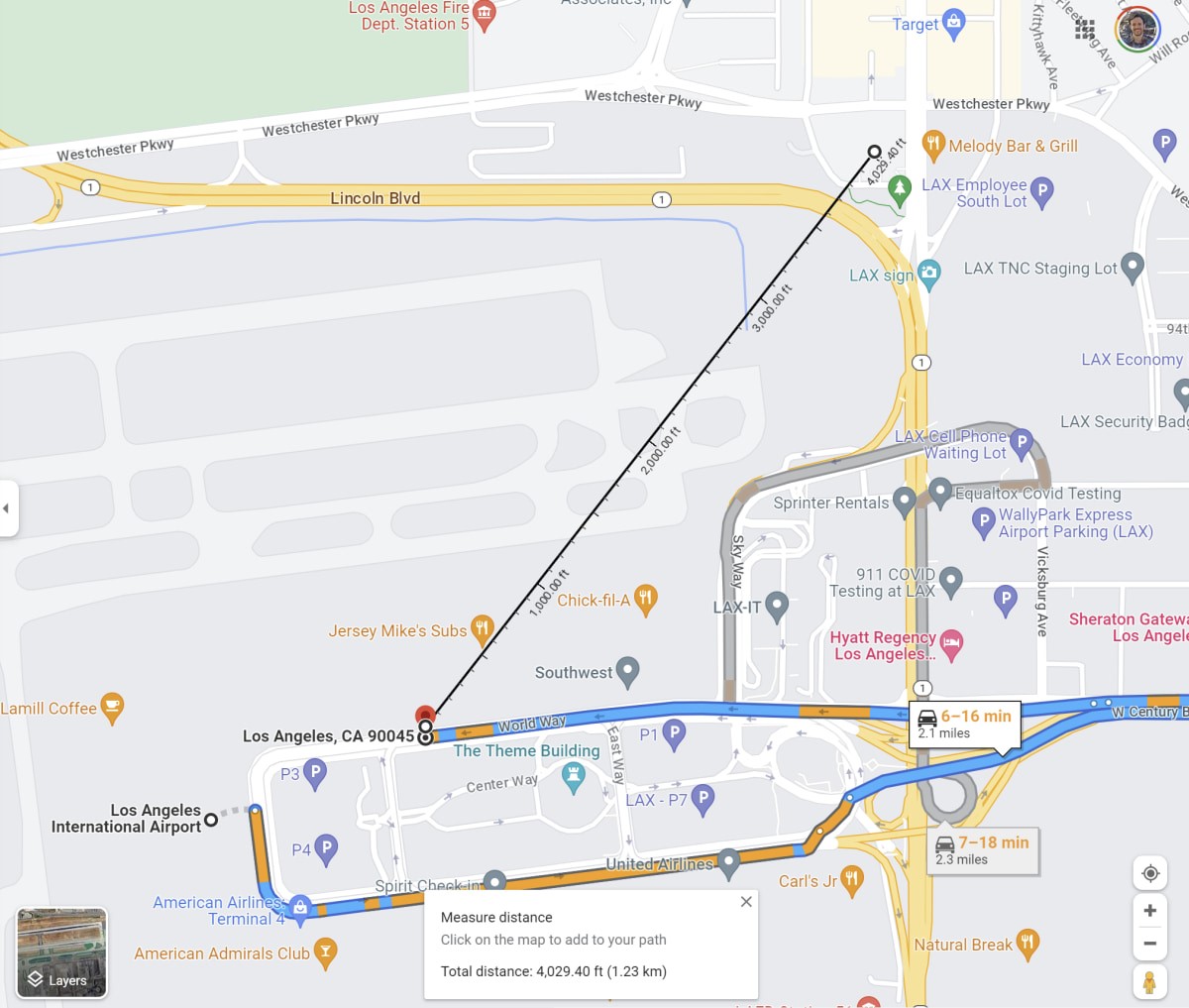
30. Save time with advanced gestures
Beyond the classic pinch-to-zoom, Maps has a bunch of other useful gestures to help you get around the app on your mobile device. Try out these advanced maneuvers:
- To zoom in or out of a Map with a single hand, double-tap and then slide up or down on the screen without lifting your finger.
- Spin a map around to change your orientation by placing your index finger and thumb on the screen and then twisting them together to the left or right.
- Shift your perspective by placing two fingers on a map and sliding them both upward on the screen. That’ll take you into a “flyover” view of the area you’re looking at, complete with three-dimensional buildings in a lot of places.
Google Drive tips
31. Scan on demand
Most average mammals never realized it, but you can actually scan documents and receipts directly into Drive with the Google Drive app for Android.
Just open the app, tap the plus symbol in the lower-right corner, and select Scan—or save yourself some steps by long-pressing the app’s icon and selecting Scan right then and there. You can also drag and drop the Scan option onto your home screen or use the Drive widget for on-demand, one-tap access.
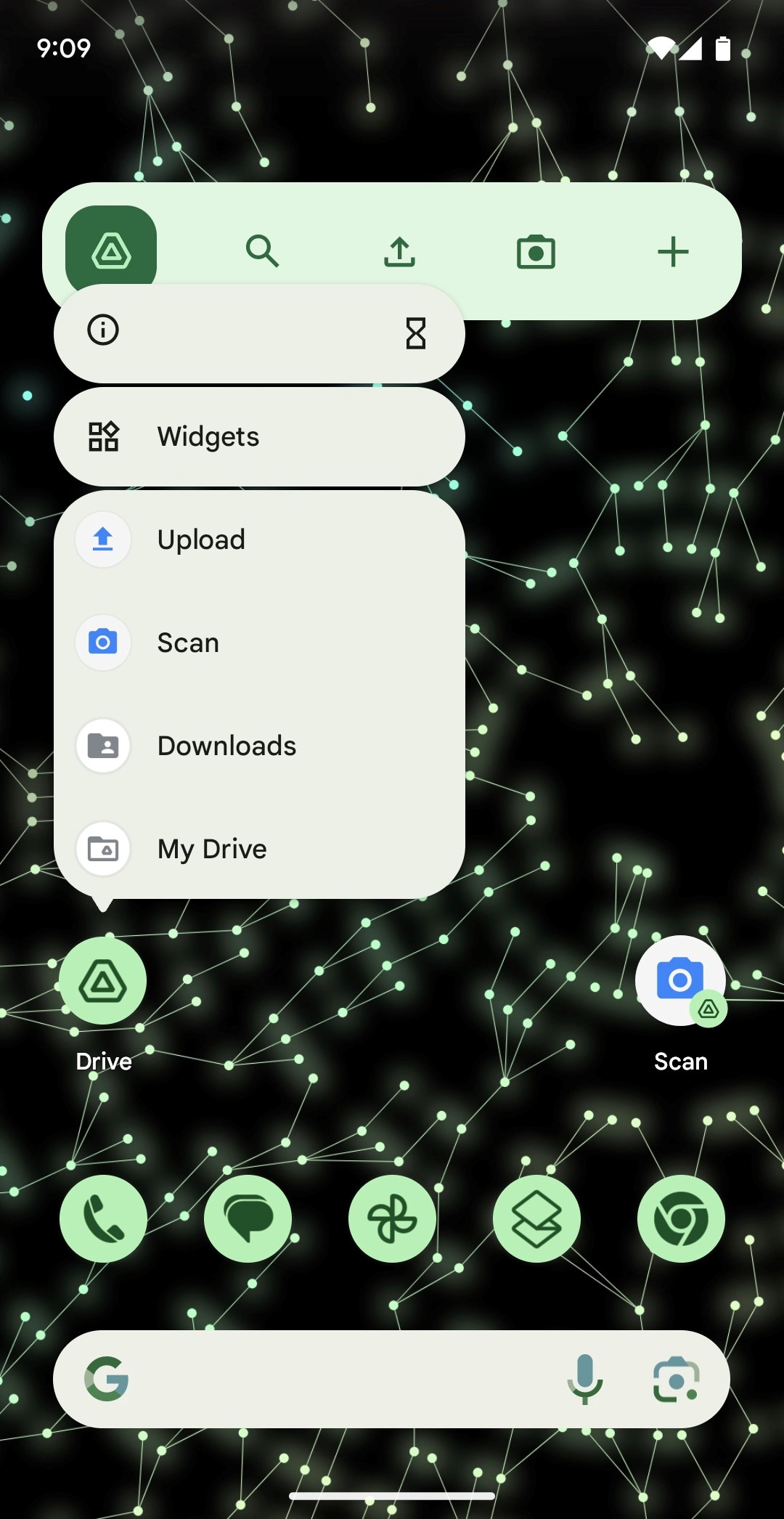
However you do it, Drive will save your image as a PDF and make its text searchable for future discovery. (And sorry, iPhone-toting pals: The option isn’t available in Drive’s iOS app as of now.)
32. Save stuff with a single click
Whenever you’re wading your way around the web on a computer, you can quickly save any web page, image, file, or screenshot directly from your browser to Drive by using the official Save to Google Drive Chrome extension.
Once the extension’s in place, just right-click any hyperlink to save its target into your Drive storage—or click the icon within the puzzle-shaped extension menu in the upper-right corner of the browser to capture and save a screenshot of your current view.
33. Maintain multiple versions of files
You’d be forgiven for failing to notice, but Drive has a potentially life-saving option to maintain multiple versions of any file for easy reference and later retrieval. You can use it with a PDF, an image, an archive, an audio file—you name it.
To get started, right-click a file in Drive and select Manage versions within the “File information” menu. Click the Upload New Version button to upload the file’s new version, then repeat that process as needed. Drive will show just a single file in its main interface, but when you right-click the file and select “Manage versions,” you’ll be able to see and download all the versions you’ve created.
Just keep in mind that, by default, only 100 older versions will be saved—and all older versions will be deleted after 30 days. You can tell Drive to hang onto a version eternally by clicking the three-dot menu icon next to the file’s name and selecting “Keep forever” from the menu that appears.
34. Search for stuff within your files
In addition to being able to search for text within regular documents and even PDFs, Drive can find images in your storage via a simple keyword search.
Just type whatever you’re looking for into the search box at the top of the site—”sunset,” “computer,” even a specific color, say—then click the downward-facing arrow within the search box and set the Type field to Photos & images. Drive will show you every image that matches the description you entered.
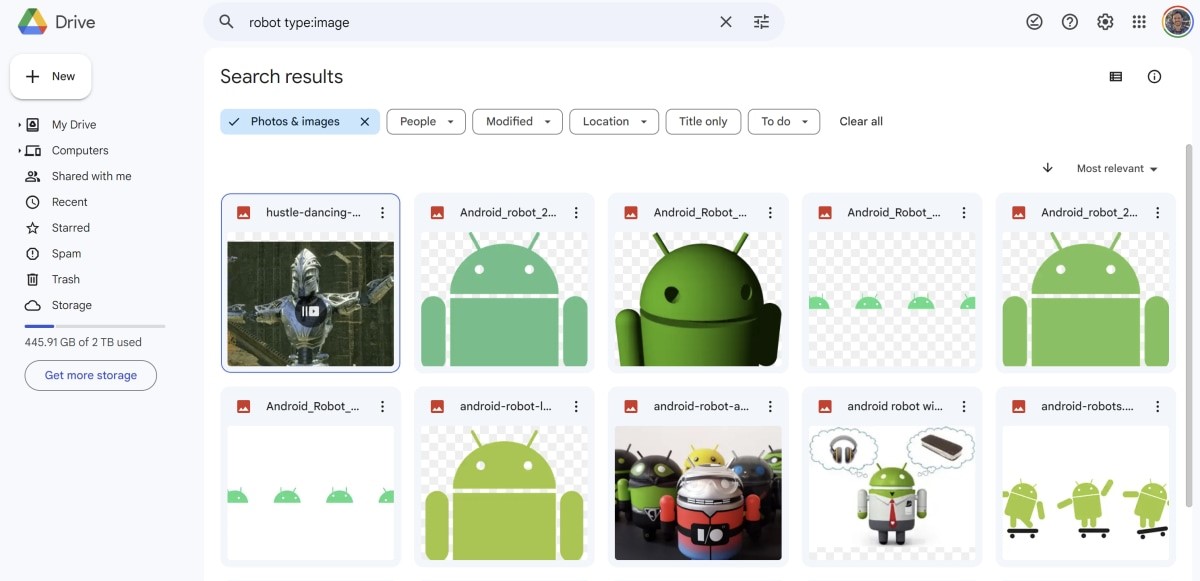
35. Sort your storage
Running out of space? Let Drive identify your biggest files so you can see what’s eating up your storage and clear out some room.
Start by clicking “Storage” on the left side of the Drive website. Then all your Drive files will appear in order of size, starting with the largest. You can even click the “Clean up space” option if you want some suggestions on stuff to delete.
36. Set a timer on your sharing
If you have a paid Google Workspace account, you can opt to make a file in your Drive storage available to someone else for only a limited period of time.
Right-click the file on the Drive website and select Share, then type in the name or email address of the person with whom you want to share and click Send. Once that’s done, make your way back to that same sharing menu—and this time, click the downward-facing arrow to the right of the person’s name (alongside Viewer, Commenter, or Editor).
Look for Add expiration in the menu that pops up, and you’ll be able to set a date on which the access will expire, then click Save.
Google Docs tips
37. Tap into a swift shifting trick
The next time you need to move text within a document, skip cutting-and-pasting for this faster way: When viewing a document within Docs on the web, just highlight the paragraph you want to reposition, then click and drag it with your mouse—or, in an even more efficient twist, place your cursor anywhere inside the paragraph, hold down Alt and Shift together, and use your arrow keys to move it wherever you want. (Who knew, right?!)
38. Format the faster way
With just a few quick clicks, Docs can copy the formatting from one area of text and apply it to another. The trick lies within that paint roller icon in the upper-left corner of the Docs website toolbar (to the right of the print icon). Place your cursor on the text that has the formatting you want, click the paint roller, and then click the paragraph where you want the formatting to be applied. The font, size, style, and color should all show up instantly.
If you want to apply the formatting to more than one area of text, double-click the paint roller at the start of the process. That’ll force it to remain active as you apply it repeatedly.
39. Find any command in no time
Save yourself the trouble of digging through Docs’ menus to find what you need and instead use the Alt-/ shortcut to search all available functions in no time.
Say you want to convert some text into title case; rather than digging around in the Format menu, you can simply highlight the text in question, hit Alt and then /, type “ti”—and then, when “Title Case” appears as the top option, hit Enter to apply it.
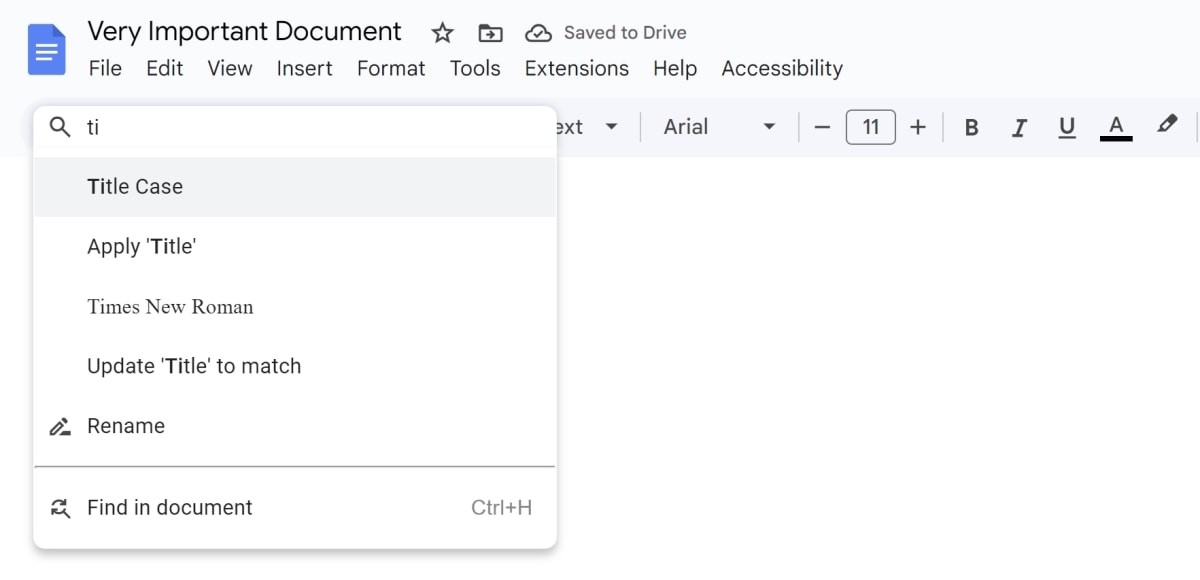
40. Dictate your document
Give your fingers a break and let Docs turn your spoken words into text: As long as your computer has a microphone, all you have to do is open the Tools menu and select Voice typing—or hit Ctrl-Shift-S (or Cmd-Shift-S)—and speak away. Docs will use Google’s standard voice-to-text system to figure out what you’re saying (mostly, anyway) and put it on the page.
41. Use your voice to format
Docs’ voice-to-text function also lets you speak commands for common forms of punctuation and paragraph formatting. You can say things like “period,” “comma,” and “question mark” or give instructions like “new line” or “new paragraph.” If you want to take a break, say “stop listening” and then say “resume” when you’re ready to continue.
42. Edit aurally
In addition to taking down text, Docs’ voice-typing mode allows you to perform advanced edits via spoken command. The system supports a huge range of functions—selecting specific words, phrases, or paragraphs; applying different types of formatting to text; cutting, copying, and pasting; and even scrolling through a document or jumping to specific parts of the page.
43. Dig up info without ever leaving your document
Docs makes it possible to do all your research without ever leaving your word processor—both on a computer and from your mobile device.
Open up Docs’ Explore tool by looking in the Explore menu (or pressing Ctrl-Alt-Shift-I or Cmd-Alt-Shift-I) on the desktop site or by finding the Explore in the mobile apps’ main menu (while you’re actually editing a document). Docs will bring up a series of web results, images, and related documents from your past work.
You can perform new searches right within that window as well—and when you find something you’d like to include in your current document, you can add it and even attach a footnote citation with a single click or tap.
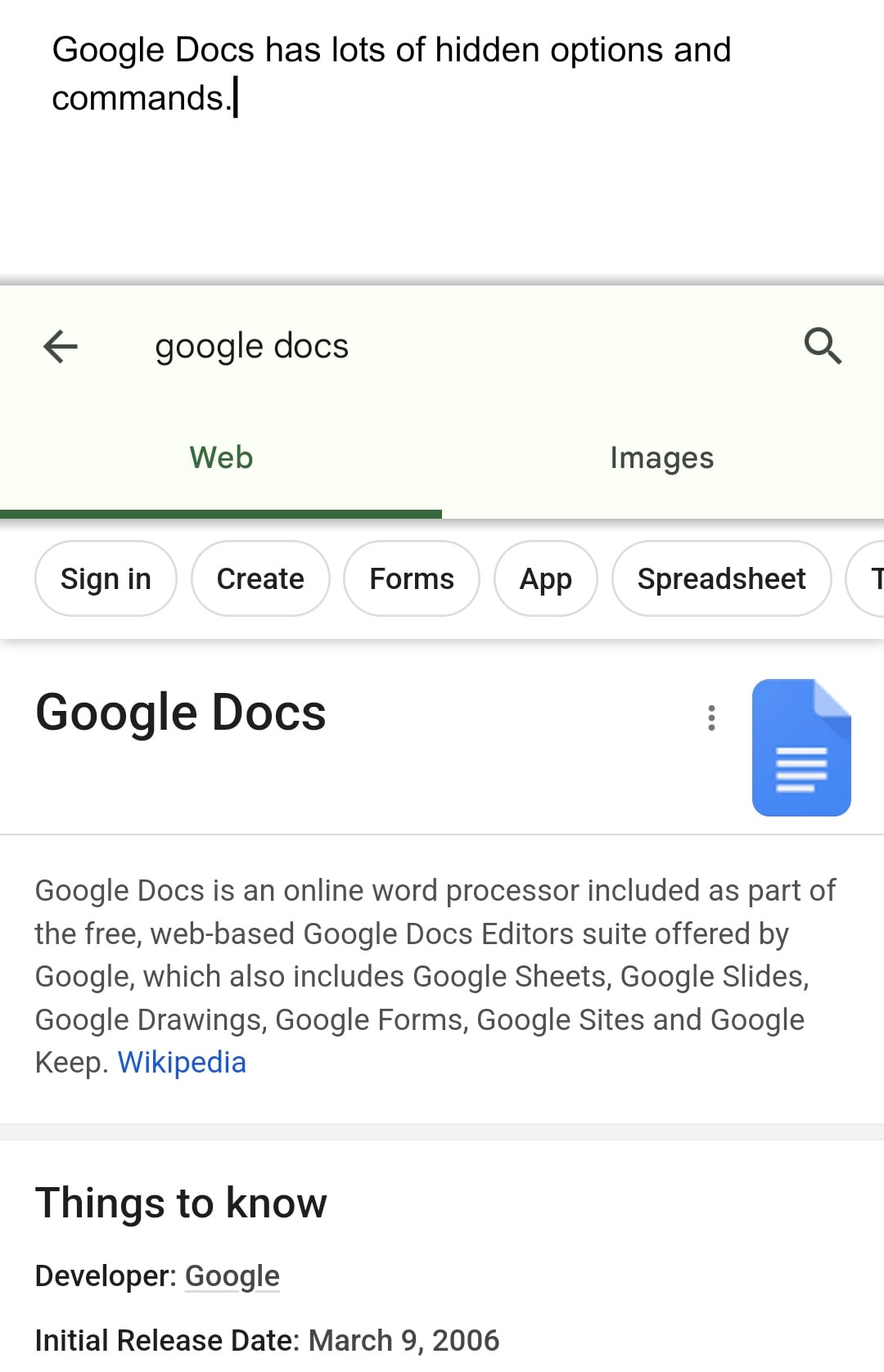
44. Connect to your own image collections
Attention, Google Photos users: Docs makes it so easy to add images from your Photos collection directly into your documents. When editing a document on the Docs website, click the Insert menu, and select Image to find the option. You can also add an image from your Google Drive storage, by URL, or by searching the web from that same area.
45. Edit images within Docs
Docs has its own tool to let you crop or edit images, too: Click on an image within your document, then click the Format menu and select Image. There, you’ll find the command for cropping as well as a broader Image Options selection that contains functions for recoloring and adjusting the image’s transparency, brightness, and contrast.
46. Get an on-the-fly dictionary check
Not confident about a word’s meaning? Hit Ctrl-Shift-Y (or Cmd-Shift-Y) with your cursor on the word. Docs will dig up a definition and show it on the right side of the screen.
47. Take note of your notes
If you use Google Keep as a note-taker, you can access your notes while working on a document and even insert an entire note into your current page.
Look for the Keep icon within the right-of-screen side panel to pull up the Keep widget. If you don’t see that side panel, look for a small left-facing arrow in the lower-right corner of the screen to reveal it.
Once the widget is visible, you can view and edit your notes. If you want to dump a note’s contents into your document, hover over the note and then click the three-dot menu icon that appears.
48. Translate anything, anytime
Don’t let a language barrier keep you from communicating. Docs has a native system that can translate entire documents into other languages: Click the Tools menu, then select Translate document. You’ll then be able to select the language you want and provide a new name for your translated file. Fácil, ¿no?
49. Email anyone without ever leaving Docs
How’s this for a hidden feature? You can email people directly from Docs to save yourself a step and make collaboration more efficient.
If you’re already sharing a document with someone, look for the Email collaborators option within Email in the File menu to get started. (Your message will come from the primary email address associated with your Google account.)
Or maybe you want to send a copy of your current document to someone via email without adding them as a collaborator—to provide the file to a client, for instance, or share it with someone outside your organization for review. Docs can do that, too: Just open that same Email option within the Docs File menu and select Email this file. You’ll be able to select from a variety of formats or even opt to include the text within the email body.
50. Create convenient in-document links
If you want to point people to a specific section of your document, use Docs’ bookmarking feature to create a direct link to any area of the text.
Place your cursor where you want the link to reside, then open the Insert menu and select Bookmark. A pop-up will appear with the link, though you’ll still need to be sure to share the document appropriately (either with the people you want to be able to view it or publicly, if you want everyone to be able to access it) before it’ll work for anyone other than you.
51. Make a PDF on demand
Need to send someone a link to a PDF version of your document?
Copy the full URL in your browser’s address bar while you’re editing the document, then change the “/edit” at the very end to “/export?format=pdf” (without the quotation marks). As long as people to whom you’re sending have access to the document, they’ll get a PDF of your work as soon as they open the link.
52. Build your own Docs template
You can use a similar trick to turn your document into a template for other people’s ongoing use: Once again, copy the full URL in your browser’s address bar while you’re editing the document—but this time, change the “/edit” at the end to “/copy” (again, without the quotation marks).
Send that link to people with whom you’ve shared the file, and when they open it, they’ll be prompted to make a copy in their own Docs storage and then work on it from there.
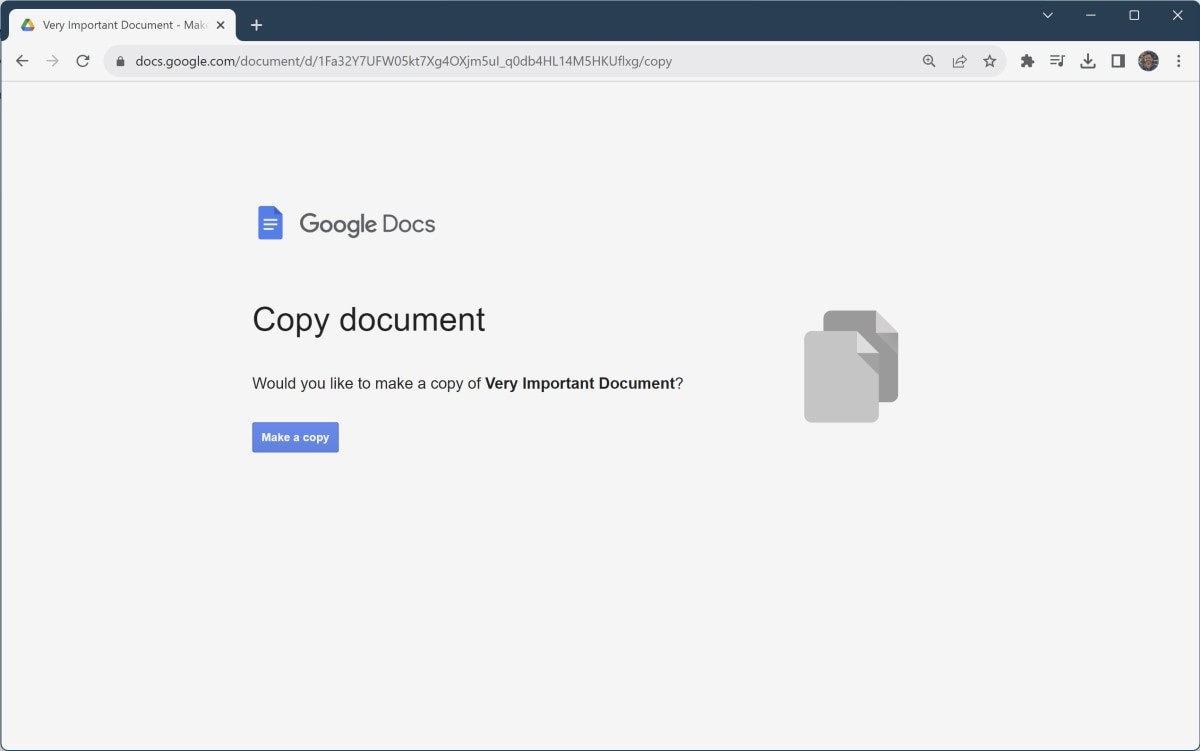
Google Sheets tips
53. Summon the date in no time
Sheets has plenty of keyboard shortcuts, but one series that’s especially worth noting is the collection of commands that quickly insert the current date and/or time wherever you want:
Hit Ctrl or Cmd and the semicolon key within any spreadsheet to add the date; Ctrl or Cmd along with Shift and the semicolon key to add the time; and Ctrl or Cmd along with Alt and Shift and the semicolon key to add the date and time together.
54. Format text fast
Google Sheets’ fast-formatting shortcuts are also worth remembering. With the right combination of keys, you can format any cell or selection of cells however you want, without having to dig around in menus.
Commit these to memory:
- Ctrl-Shift-1: Format as decimal
- Ctrl-Shift-2: Format as time
- Ctrl-Shift-3: Format as date
- Ctrl-Shift-4: Format as currency
- Ctrl-Shift-5: Format as percentage
- Ctrl-Shift-6: Format as exponent
55. Make your own custom Sheets shortcut
You can actually create your own personalized shortcut within Sheets to perform a complex series of custom actions with a single command.
Open the Extensions menu, select Macros, then select Record macro. If you want the shortcut to always be performed on the same specific cells, select the Use absolute references option; otherwise, select Use relative references. Then perform whatever actions you want to record.
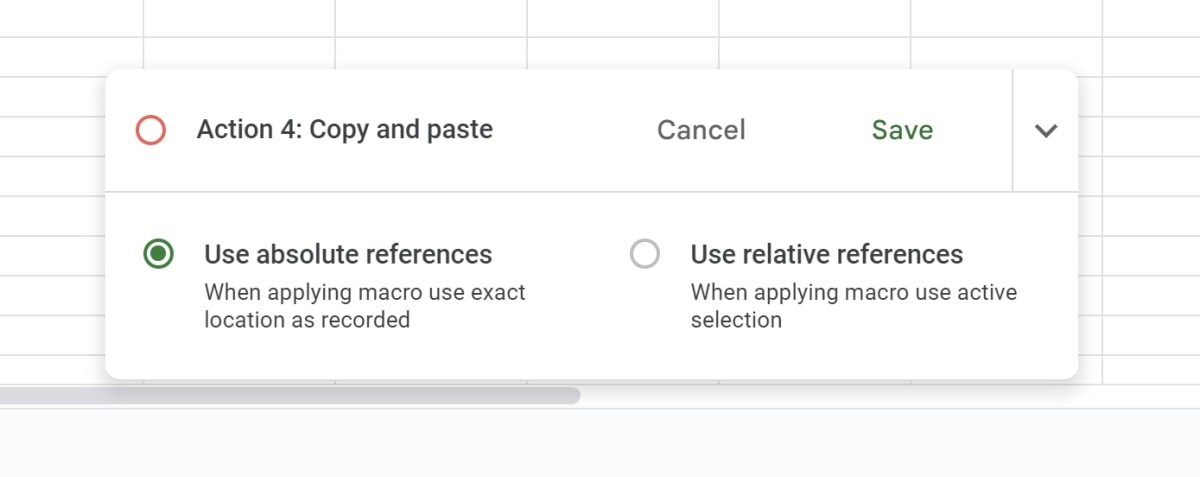
You could do something like set a specific sort of formatting for a cell’s contents (bolded white text with the Open Sans font and a dark-gray background, for instance) or you could manipulate data in a more involved manner, like copying a cell’s contents and then erasing that cell and pasting the contents one cell over to the left. When you’re finished, click Save in the macro-recording panel, and you’ll be able to give your new shortcut a name and assign it to any available key combination for future activation.
56. Copy cells swiftly
Speaking of copying a cell’s contents, if you ever need to duplicate a cell’s data and have it appear in multiple cells above it, below it, or on either side of it, click the original cell to outline it in blue, then look for the little blue square in its lower-right corner. Click that square and drag it in whatever direction you want, for as far as you need. When you let go, the original cell’s contents will instantly appear in all of the other cells you selected.
57. Link two sheets together
Need to show some live data from one spreadsheet inside another? Copy the full URL of the sheet with the data and paste it into Sheets’ ImportRange function, using the following format (with your own URL, sheet number, and cell range in place):
=IMPORTRANGE (“https://docs.google.com/spreadsheets/d/1aBcDEfgHiJKLMnOPQRSTuVWXZ”, “Sheet1!D1:D15”)
Then paste that function into the sheet where you want the data to appear. You’ll have to hover over the cell and click a button to allow the two sheets to be connected, but then—hocus-pocus! All of the data from your other sheet will magically appear and remain current whenever any changes are made.
58. Grab data from the web
Sheets can pull in data from any publicly available web page, too, as long as the page has a properly formatted table. The secret lies within the ImportHTML command. Use it with whatever URL you need and the number indicating which table on the page you want to import (“1” for the first table, “2” for the second, and so on):
=IMPORTHTML(“https://en.wikipedia.org/wiki/List_of_sandwiches”,”table”,1)
And just like that, all of the info will appear within your spreadsheet.
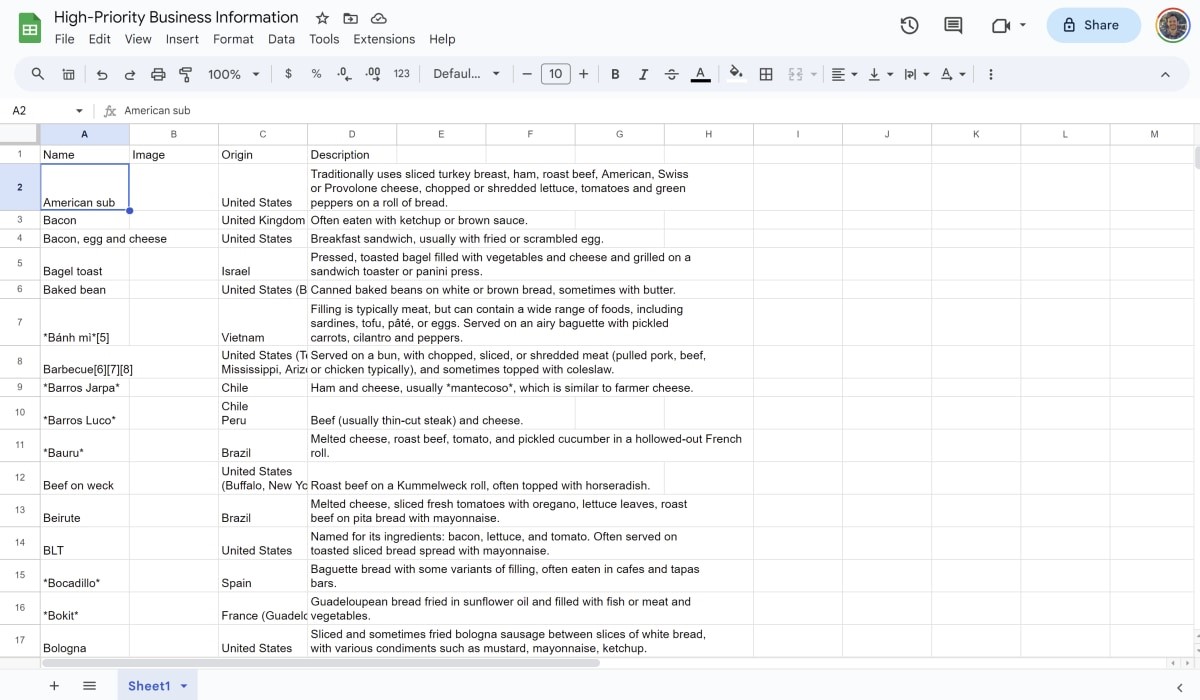
59. Bring any feed into your sheet
A similar kind of command can let you import recent entries from a website’s RSS feed into any spreadsheet. All you do is enter the ImportFeed command along with the URL of the feed you want. For instance, if you wanted to see all my Fast Company stories in Google Sheets, you could enter:
=IMPORTFEED(“https://fastcompany.com/user/jrraphael/rss”)
If you wanted only the titles of the stories—and wanted only, say, the most recent five entries—you could add in the following parameters:
=IMPORTFEED(“https://fastcompany.com/user/jrraphael/rss”,”items title”,false,5)
And then if you wanted to place the links to each story in a separate column alongside that, you could use this:
=IMPORTFEED(“https://fastcompany.com/user/jrraphael/rss”,”items URL”,false,5)
60. Eliminate extra spaces
If you spot some extra spaces before or after data in your spreadsheet, whether you’re looking at numbers or text, don’t forget the Google Sheets function TRIM. You can type it in for whatever cell you want (=TRIM(A1), for instance), and it’ll take away any leading or trailing spaces, and give you a cleaner version of the cell’s value.
If you want to perform the function for multiple cells at once, use this format for whatever range you need:
=ArrayFormula(TRIM(A2:A50))
61. Fix your formatting
Looking at lots of data with RanDoM or ImPropeR CaPitaLiZaTion? Sheets can standardize case formatting for you with a few simple functions:
=Upper(A1) will make all the text uppercase for whatever cell you mention; =Lower(A1) will do the same with lowercase; and =Proper(A1) will capitalize the first letter of each word for a title-case effect.
62. Enforce your email addresses
Maybe you have a database of user-submitted email addresses. Tell Sheets to look through the addresses and determine if they’re all properly formatted: Use the function IsEmail(A1) with whatever cell you need—or if you want to perform the function for a range of cells, use this format:
=ArrayFormula(ISEMAIL(A2:A50))
Sheets will give you a True or False answer for every email address you feed it.
63. Check out a chart
You can easily create a tiny chart within a single cell using Sheets’ nifty Sparkline feature. Just type the command =Sparkline followed by the cells you want to include, the word “charttype,” and then the type of chart you want to create—such as line, bar, or column—formatted like this:
=SPARKLINE(E12:E23,{“charttype”,”column”})
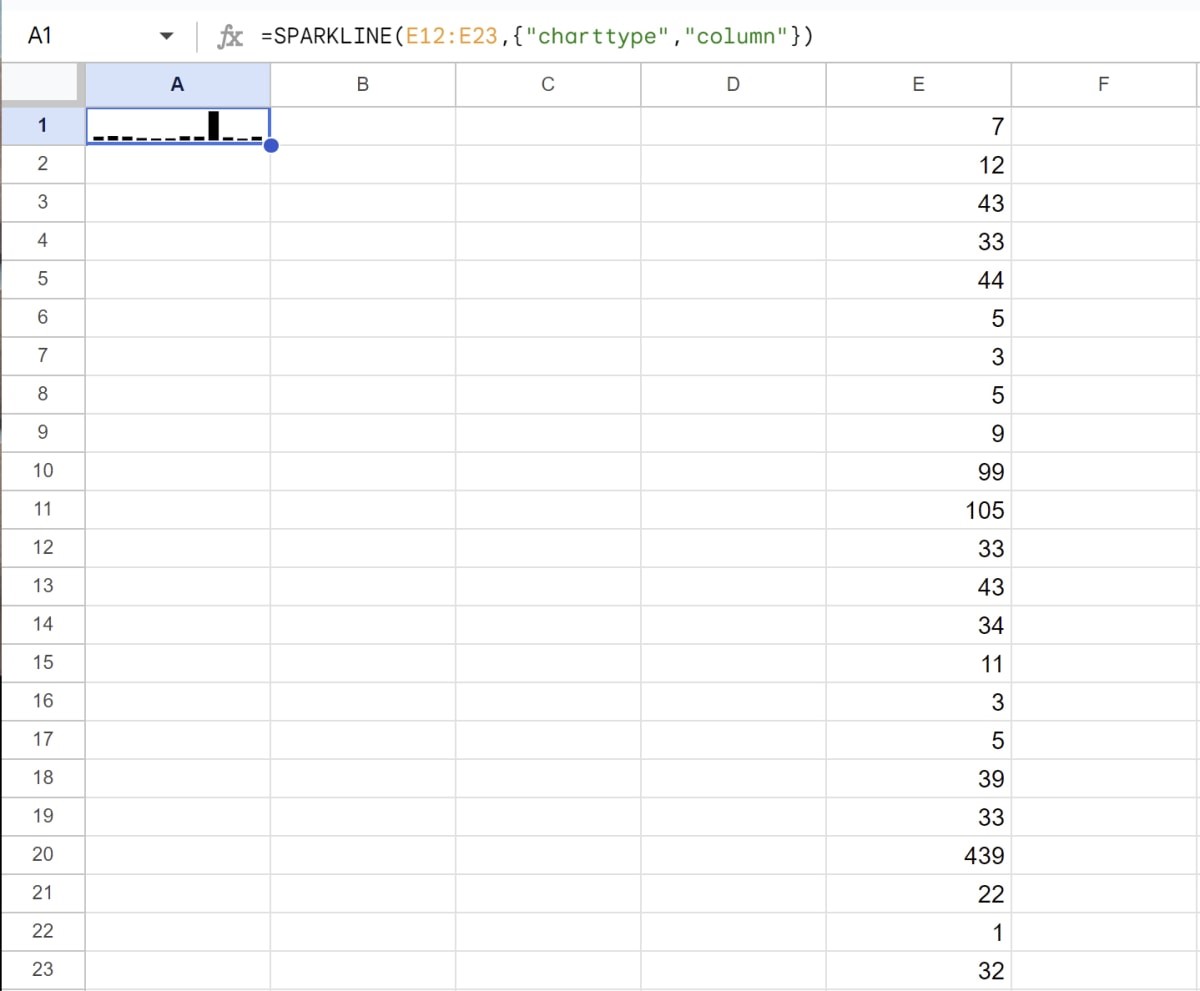
If you really want to get wild, you can even include a variety of customization commands that’ll control the colors used in different parts of your chart along with other visual factors.
64. Add some color to your rows
Want a quick and easy way to make your spreadsheet shine? Look for the Alternating Colors option in Sheets’ Format menu. It’ll give you a simple set of options that’ll apply a sharp-looking color pattern to your rows—no thought or effort required.
65. Try a Sheets text trick
While you’re jazzing up your spreadsheet’s appearance, think about letting Sheets rotate the text in your header row. Highlight the row, then click on the icon that shows an “A” with a right-facing arrow beneath it (toward the right of the top-of-screen toolbar—or possibly within the three-dot menu icon, if your window width is narrow).
You can then pick from several eye-catching effects that’ll set your header text apart and give your spreadsheet a snazzy new look.
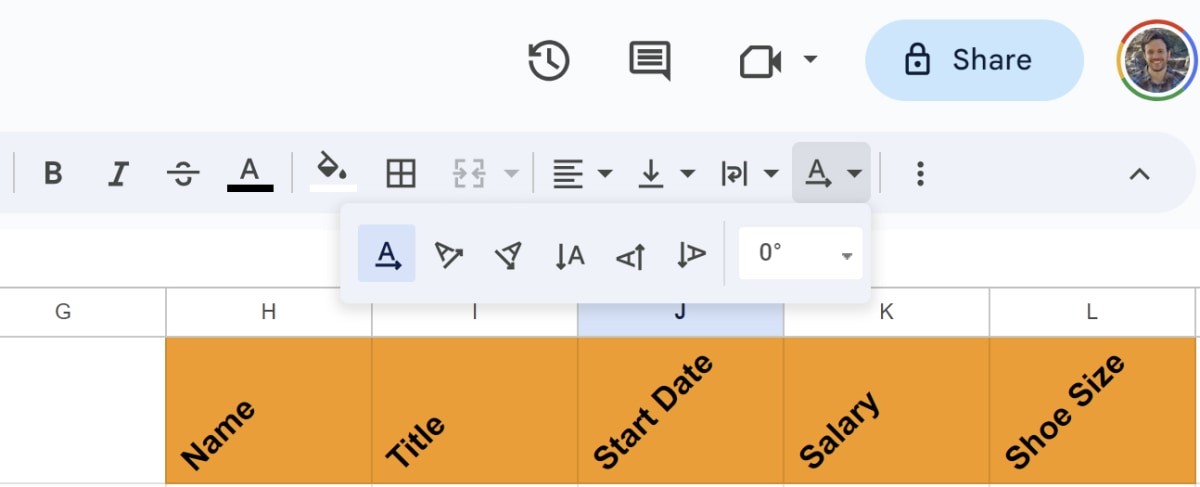
66. Stay on top of edits
When you’re sharing a spreadsheet or using a form to accept survey-like responses, you can ask Sheets to notify you whenever an edit or addition occurs—either immediately or as a once-daily email digest. Look for the Notification settings option in the Tools menu to set your preferences for any particular spreadsheet.
67. Finesse financial data
Sheets has the power of Google Finance (which—who knew?—is still a thing) baked right in for your stock-knowledge needs. The system is able to give you real-time or historical stock prices along with all sorts of other market-related data for any publicly traded company.
Simply use the function GoogleFinance followed by the info you desire, using the variables and formats described on this page.
68. Translate right within Sheets
Ever find yourself scrolling through a list of responses in different languages? Sheets can identify any language used in a spreadsheet and even translate it into your own native tongue on the spot. To detect a language, use the following function (with the appropriate cell number in place of “A1”):
=DETECTLANGUAGE(A1)
You can also enter in a word in place of a cell number, if you want:
=DETECTLANGUAGE(“pepinillo”)
Google will give you a two-letter code telling you the language that was used. To translate, meanwhile, use the following command—with your own word or cell number in place of “A1” and the code for whatever language you want to translate into (if it’s anything other than English, as referenced below):
=GOOGLETRANSLATE(A1,”auto”,”en”)
It just goes to show you: Much like the language of love, the language of spreadsheets truly is universal.
Google Search tips
69. Go back in time when a site’s offline
Trying to reach a site that’s temporarily down or permanently offline? Type “cache:” followed by the site’s address directly into Google. That’ll take you to a recently saved version of the site hosted on Google’s own servers.
70. Let Search decide your fate
The next time you need an impartial judge to help make a decision, try typing “random number generator” into Google. That’ll bring up a tool that lets you specify a minimum and maximum number—for however many choices you have, or even representing a specific set of values within a spreadsheet—and then have the Google genie randomly pick a number within that range.
For a more visual (although also more limited) version of the same concept, type “Spinner” into Google and then switch the toggle at the top to Number. You can then create a wheel with anywhere from 2 to 20 numbers and click it to spin and land on a random digit.
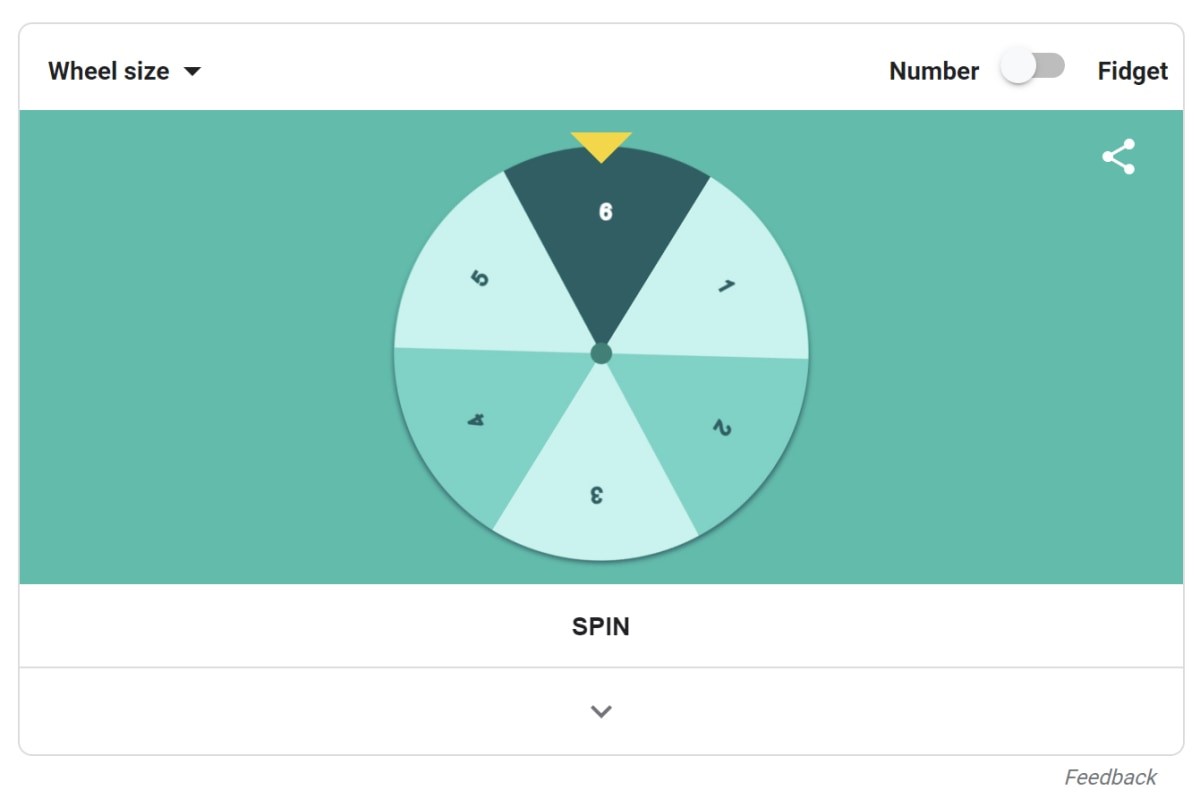
And for even simpler decisions, let Google flip a coin or roll a die for you by typing either command into the search box. (Bonus tip: You can also ask Google to spin a dreidel.)
71. Keep track of time
Make Google serve as your personal time-keeper by typing “timer” or “stopwatch” into a search box. You can also launch right into a specific timer by typing “20 minute timer” (or whatever amount of time you desire).
72. Perform advanced calculations
You probably know that Google can act as a basic calculator, performing addition, subtraction, and so on—but did you know it can also do all sorts of advanced mathematics? For instance, you can have Google graph complicated equations like “cos(3x)+sin(x), cos(7x)+sin(x)” by entering them directly into the search box. And you can fire up a geometry calculator by searching for a specific query—”area of a circle,” “formula for a triangle perimeter,” or “volume of a cylinder”—and then entering in the values you know.
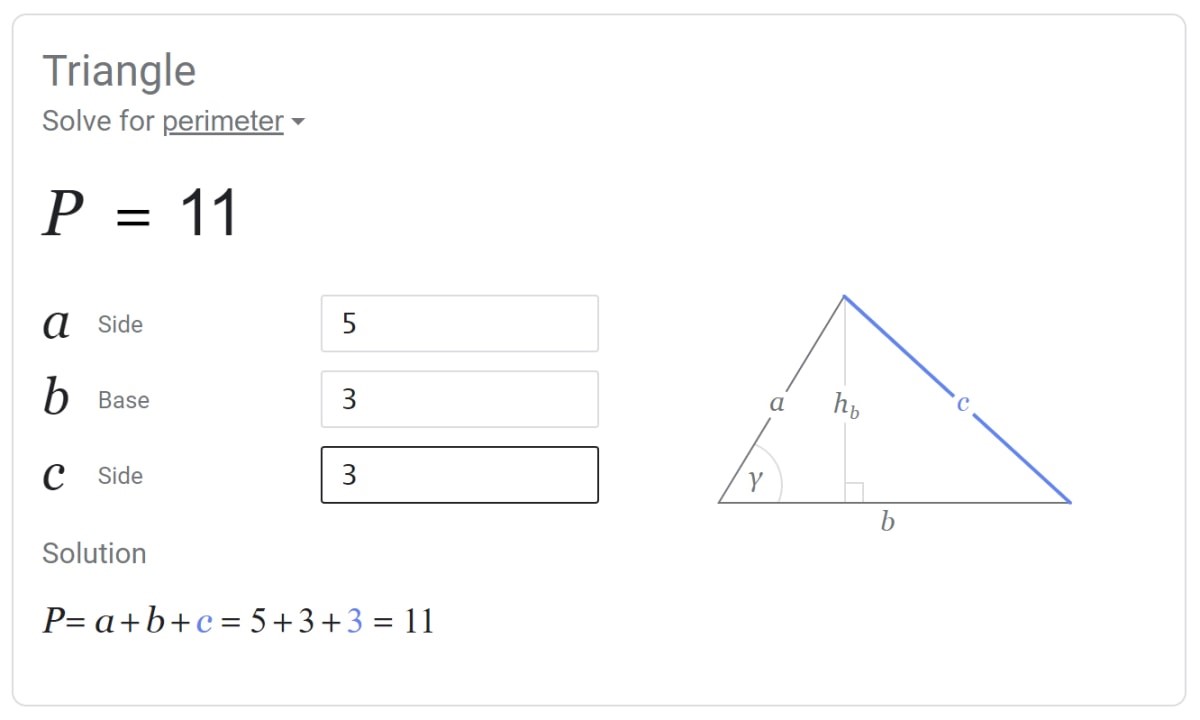
Google has separate stand-alone calculators that can figure out tips and monthly mortgage payments, too. Search for “tip calculator” or “mortgage calculator” to give either a whirl.
73. Convert anything, anytime
The next time you need to convert between units, ask Google to do the heavy lifting for you. In addition to handling currency and practically any measurement system, Google can convert megabytes to gigabytes, Fahrenheit to Celsius, and days into minutes or even seconds.
You can explore all the possibilities by typing “unit converter” into the search box and then looking through the dropdown menus that appear—or you can perform most conversions directly by searching for the exact changeover you want (e.g. “14.7 lbs to oz”).
74. Turn digits into words
Who among us hasn’t come across a sprawling number and stared at it blankly while trying to figure out how to say it aloud? Search for any number followed by “=english”—”53493439531=english,” for example—and Google will spell out your number for you in plain-English words.
75. Get a helping color hand
Designers, take note: Searching for “color picker” will pull up a simple tool that lets you select a color and find its hex code, RGB value, CMYK value, and more—and easily convert from one color code type to another.
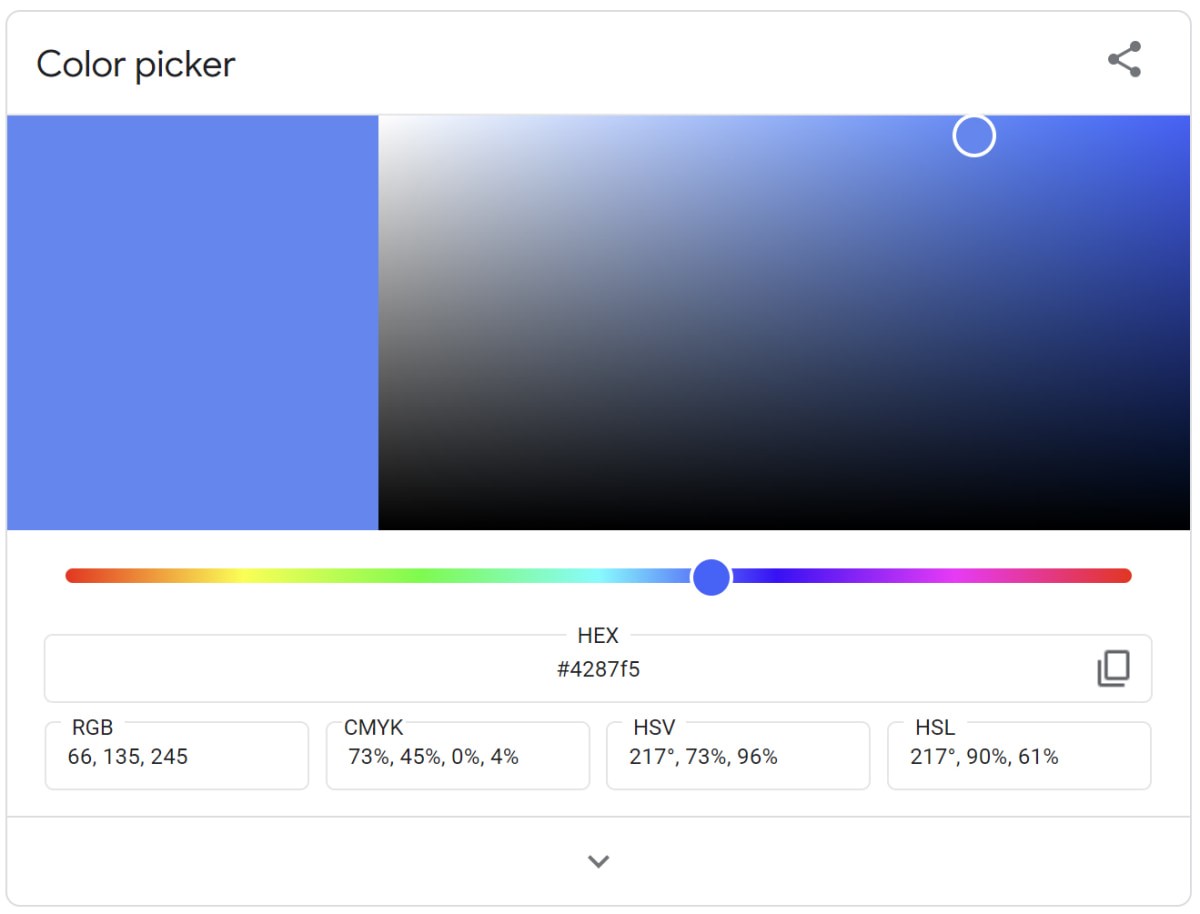
You can also see an identifying swatch for a specific color code by typing it into Google in almost any form: “#fcef00,” “rgb(252, 239, 0),” “pantone 444 u,” and so on.
76. Start your streaming adventures
Figure out which streaming service has the show or movie you want by searching for “watch” followed by the program’s title. Google will give you a list of places where you can find it—both as part of an active subscription and on an à la carte purchasing basis.
77. Have some fun
When you’re ready for a break, let Google entertain you with a hidden Search game. Try searching for some of the following terms:
- Google Pacman
- Solitaire
- Minesweeper
- Tic Tac Toe
And last but not least, take a trip back in time by searching for “Google in 1998.” That’ll let you look through one of Google’s earliest site designs, from the time of the company’s launch—and make you appreciate just how far things have come.
For even more next-level Google knowledge, check out my free Android Intelligence newsletter and get three fresh and useful tips in your inbox every Friday.
(3)
